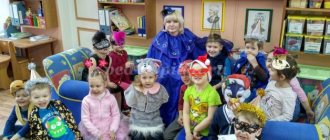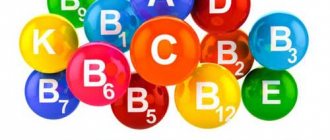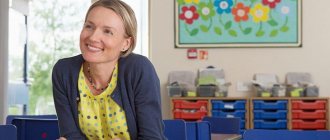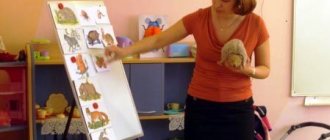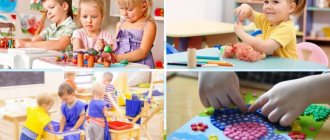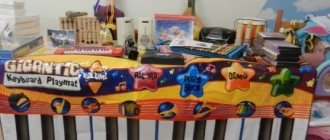Self-analysis for the integrated lesson “Walking with a Kolobok”, junior group
Self-analysis of Organized Educational Activities
on the topic of:
"Walk with Kolobok"
(junior group)
Target:
identify the level of development of children’s knowledge and ideas during the school year.
Tasks:
Educational:
Create conditions for securing geometric shapes, highlighting their properties (color and shape).
Create conditions for using the expression “how many”, “many”, “one”
Create conditions for repetition of general concepts: domestic and wild animals.
Improve the ability to name and distinguish between young domestic animals.
Create conditions for the fixation of vegetables and fruits (where they grow)
Create conditions for consolidating the ability to select words that are opposite in meaning (“on the contrary”).
Educational:
Provide conditions for encouraging children to engage in speech activity and encourage them to engage in dialogue.
Promote the development of logical thinking, attention, imagination, visual perception.
To promote the development of motor activity of children in educational activities.
Improve children's ability to form nouns with
using diminutive suffixes.
-improve children’s ability to use nouns in speech with
prepositions (in, on, under, about).
-Create conditions for the development of fine motor skills.
Educational:
Foster and encourage initiative and independence.
Cultivate interest in organized educational activities.
Cultivate kindness and curiosity.
Priority educational area:
cognitive development (FCDM).
Integration of educational areas
: Cognition, Communication,
Socialization, Artistic creativity.
Activities:
communicative, cognitive, musical, motor, gaming.
Methodical techniques:
Gaming:
surprise moment: bun, classification by subject; puzzles; explanation.
Verbal:
questions for children, repetition and clarification, reminder, encouragement.
Visual:
picture - rules, toys of wild and domestic animals, models of fruits and vegetables, tree, “bed”, 3 multi-colored hoops, cubes, balls.
Practical:
putting fruits and vegetables into baskets, classifying animals, guessing riddles, playing with three hoops, speaking the other way around, making koloboks.
Health-saving technologies:
change of activity, psycho-gymnastics, physical minute.
Preliminary work:
learning poems, talking about fruits and vegetables, wild and domestic animals and their young. Studying primary colors, geometric shapes, modeling salt dough.
Equipment:
toys: bun, bear, wolf, hare, fox;
demonstration material: cubes, plastic balls; figures of domestic and wild animals; dummies of vegetables and fruits; baskets, a picture with rules, boards for modeling, napkins.
To carry out this DEA, the following was compiled:
- Summary of educational activities, attributes have been prepared, the group has been formed in accordance with the theme of OOD and safety rules;
- Demonstration material has been prepared and rationally placed
(tree and bed, house, Christmas tree, multi-colored hoops);
- Handouts have been prepared (modeling boards (according to the number of children), colored salt dough for each child, napkins)
The lesson was carried out in accordance with the notes. The abstract was compiled independently, in accordance with the objectives of the basic general education program, corresponding to the given age of the children. To implement each task, techniques were selected in an interesting and entertaining way. Throughout the lesson, visual aids were used to stimulate and activate children’s thinking. Their placement and use was rational, thoughtful in the learning space and in the lesson. Music was used during the lesson to enhance emotional perception. The educational activity was planned and carried out in a playful way, based on the children’s existing knowledge and additional work. In the course of solving game-based learning situations, children had the opportunity to show their stock of accumulated knowledge. The whole move is thought out, all parts are interconnected and united by one common plot. The OOD consisted of 3 parts (introductory, content and reflective). In the first part of the OOD, the organizational technique “Greeting” in poetic form was aimed at developing communicative qualities and establishing friendly relationships both within the children’s team and between guests and children. The lesson is dynamic, it includes techniques that provide for a quick change of activity. “A surprise moment”, finding a way out of a problematic situation with a kolobok, a walk in a magical forest - moving around the group, conversation.
All points are logical and consistent. The lesson expanded and generalized children's ideas about familiar fairy tales and rules of behavior in the forest. About wild and domestic animals, about vegetables and fruits. Reinforced children's knowledge of primary colors and geometric shapes. We activated our vocabulary by playing “in reverse”. We developed fine motor skills through finger gymnastics and kolobok sculpting—working with dough. We improved children’s ability to show care and independently express kindness.
When building a cognitive lesson, we took into account the development of physical abilities: the textual content of the physical training session was accompanied by movements to develop motor activity.
The techniques in the lesson were of a playful nature and were based on game-based learning situations, in accordance with the Federal State Educational Standard.
At every moment of the lesson, we tried to guide the children to find solutions to the problem, helped consolidate knowledge, activate independence and maintain a positive, emotional attitude. The creation of search problem situations intensified the mental and speech activity of children.
During the lesson, we tried to communicate with the children on the same level, and tried to maintain the children’s interest in the lesson throughout the entire time.
Summing up the results of the lesson was organized in the form of reflection, using the method of analysis, the success of completed tasks and the method of self-assessment by children of their achievements and the capabilities of their peers. We believe that the goal we set has been achieved and the tasks have been fully realized.
